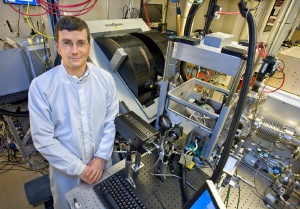Berkeley Lab scientists stunned the world in 2006 when they proved they could accelerate electrons to very high energies (1 GeV, or a billion electron volts) in a distance of centimeters rather than hundreds of meters. Using the same concepts, those scientists plan to take the project to the next level and build a laser-based accelerator capable of zapping electron beams to energies exceeding 10 GeV in a distance of just one meter.
 Wim Leemans is the project leader of BELLA, a planned laser plasma accelerator that will receive $20 million from the American Recovery and Reinvestment Act.
Wim Leemans is the project leader of BELLA, a planned laser plasma accelerator that will receive $20 million from the American Recovery and Reinvestment Act.
When completed in about four years, the Berkeley Lab Laser Accelerator, or BELLA, will demonstrate the promise of a novel and compact method of accelerating high-energy particles, by making use of a series of synchronized laser systems. The results will be of interest not only to high-energy particle physicists but also to chemists, biologists, doctors, and national security officials.
BELLA, which will receive $20 million in funding from the American Recovery and Reinvestment Act, was the only science project on the list for Berkeley Lab when the Department of Energy announced $115.8 million in Recovery Act funding for the laboratory in March. The rest is allocated for construction and upgrades of office and laboratory space and for building a prototype high-speed data network. (For more about the infrastructure projects, click here.)
With a total budget of about $28 million, BELLA is expected to generate approximately 50 jobs. That includes both on-site workers, such as laser technicians, engineers and construction teams to upgrade the building that will house the laser, and off-site workers at the companies that will supply the supporting systems. About $7 million will go towards construction and safety; the rest will go towards procuring the laser and everything needed to assemble and run it, such as optical, diagnostic, and other technical systems. The entire system will be housed in an existing building at Berkeley Lab, which will be reconfigured and upgraded to include a clean room, new laser lab space and additional shielding.
Project leader Wim Leemans has spent much of his nearly 18 years at Berkeley Lab building lasers and working with laser accelerators. Collaborating with Simon Hooker of the University of Oxford, he and members of his group achieved a major breakthrough in 2006 when they broke the world record for laser-wakefield acceleration, a technique in which particles are accelerated by waves in plasma generated by intense pulses of laser light. In the wake of the laser pulse, electrons surf the waves of the ionized gas. Leemans and coworkers used this concept to accelerate electron beams to energies of more than 1 GeV in a distance of just 3.3 centimeters. Compare that to the Stanford Linear Accelerator Center, or SLAC, which takes 2 miles (3.2 kilometers) to boost electrons to 50 GeV.
Although the main purpose of the project is to develop a new generation of more compact accelerators for high energy physics research, laser plasma wakefield technology has several potential applications. A multi-GeV beam could be used to produce highly-collimated, high-energy photons that could penetrate cargo in a nondestructive way, allowing inspectors to remotely “see” inside a package, which would be highly useful for national security. BELLA could also be used to build free-electron lasers (FEL). Like all lasers, FELs emit energetic beams of light. But unlike conventional lasers, they operate on a different set of principles that make them highly tunable. Because of this property, free-electron lasers can provide extraordinarily valuable tools for materials scientists, chemists, biologists, and researchers in various fields working on problems in fundamental energy research, allowing them to probe ultrashort, nanoscale phenomena. Their tunability also makes them useful for medical diagnosis.
Finally, with some modification, BELLA could produce a narrow bandwidth x-ray beam that could be used to take very high-resolution x-ray images for medical use. If the laser technology that drives the laser plasma accelerators keeps on improving by becoming less expensive and more compact, it could one day be an alternative to conventional x-ray machines, offering a new technique for better images with reduced x-ray dose.
Laser plasma accelerators have the potential to drastically cut the costs of performing accelerator-based scientific experiments due to their much reduced size compared to conventional accelerators of the same energy. While it may be decades before a laser plasma accelerator is built for basic physics research, BELLA represents an essential step towards investigating how more powerful accelerators of the future might be more compact. Systems like BELLA hold the promise of making possible a table-top accelerator with particle energies in the tens of GeV range that could be compact and affordable enough for a wide range of applications.
On the international stage, plasma wakefield accelerator research is highly competitive. Groups in the UK and France are working feverishly to best the record set by Leemans’ group in 2006. China has also deemed it a high-priority growth area. “Everybody’s trying to get to 10 GeV now,” said Leemans. “It’s a big deal. If the project goes according to schedule, we have the best technology to do it first.”